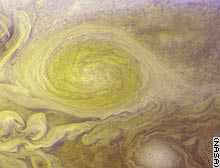 Small moons are acting as shepherds using their gravity to herd dust and boulders in Jupiter's faint rings, NASA scientists reported Tuesday. Small moons are acting as shepherds using their gravity to herd dust and boulders in Jupiter's faint rings, NASA scientists reported Tuesday.
The finding is one of several discoveries made from images captured in late February by the New Horizons probe in what NASA scientists called "a real-world fly-by" of Jupiter, 16 months into its mission to Pluto.
They also got the closest look yet at the "Little Red Spot," an Earth-sized swirling storm that scientists described as a galactic rendition of Vincent Van Gogh's "Starry Night" painting, and dramatic views of volcanic eruptions on Jupiter's moon Io.
These postcards from Jupiter were taken by the piano-sized robotic probe's seven cameras as it came within 1.4 million miles of Jupiter February 28. About 70 percent of the data has been relayed to Earth so far.
The close encounter allowed New Horizons to make use of Jupiter's gravity to shave three years from its travel time to Pluto. It is expected to arrive in 2015.
The encounter with Jupiter "was a chance to practice ... before the rubber hits the road" with Pluto, Alan Stern, New Horizons principal investigator, told a televised news briefing.
Pictures of Jupiter's faint rings revealed the moons Metis and Adrastea herding rocks with their gravitational pull.
"The boulder-sized particles are definitely being controlled by these shepherding satellites," Jeff Moore of the NASA Ames Research Center in California told the briefing.
Also spied was what appeared to be remnants of an object that had recently collided with the rings. "Individual clusters of particles in the rings is a really new discovery," Moore said.
On Jupiter's volcanic moon Io, New Horizons revealed an umbrella-shaped plume rising 200 miles into space from the volcano Tvashtar.
"It's really exciting that it performed for us," said John Spencer of the Southwest Research Institute in Boulder, Colorado. "Galileo was orbiting for six years and we never saw plumes like that," he said, referring to an earlier mission. The probe also revealed a mystery volcano, so young its lava has just reached Io's surface, but has yet to emit enough gas to produce a plume.
"We're seeing the birth of a new volcano here," Spencer said. In about eight years, the mission will produce the closest-ever views of Pluto and the hundreds of other icy objects in the distant Kuiper belt region. But for now, the NASA scientists are happy with the test drive. "I think we're ready to rock and roll." Stern said. | 